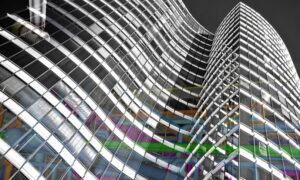The 3-dimensions of Building Performance
An integrated design approach must be applied in a building design with the blend of advanced computer simulation techniques to validate and achieve a balance in all three dimensions of building performance.
Building performance has become an imperative element in design and operations of buildings of recent times. Often associated with energy efficiency, building performance actually has a great more deal with other vital aspects of human life. It was relevant in the early struggle for better buildings but today the demands are even more challenging: besides not wasting energy, buildings must also address health and wellness of their inhabitants.
A building can have both positive and negative effects on performance. Negative effects are associated with discomforts, distractions or health risks that interfere with peoples’ ability to do their work whereas positive impacts are associated with enhancing work performance, psychosocial well being, and health to enhance overall performance.
Buildings can also be responsible for major health challenges we are facing today, including everything from asthma to depression. On the other hand, buildings can also positively promote human health, particularly with focusing on the indoor air quality, active design strategies, natural lighting and healthy material selection.
Apparently, building performance has to be dealt in 3-dimensions i.e. Health, Comfort and Efficiency.
Implications of Energy Efficiency on Comfort & Health
Buildings consume over 40 percent of world’s total energy and thereby CO2 emissions. With alarming global warming concerns and ever increasing energy costs, energy efficiency has received first priority in the discussion of building performance. The world is now sensitised to a great extent and thus, striving to achieve higher and higher energy efficiency in the buildings.
In the quest of saving energy, however, one should not forget that the primary reason of a building’s existence is to be used by humans. Achieving energy efficiency at the cost of human comfort and health must certainly not be the goal.
For instance, an airtight building made for higher energy efficiency – if not provided with sufficient ventilation – leads to a common problem of building up of carbon dioxide and various pollutants. This leads to “sick building syndrome,” the term introduced in 1980s to describe the increasingly common maladies caused by improperly designed and ventilated buildings.
On the other hand, excess ventilation for comfort and health shall lead to higher energy consumption and an air-leaked building may even let outdoor pollutants to infiltrate in the building causing health issues for its occupants.
Implications of Visual Comfort on Health
Performance enhancement is more likely to come from a different set of building features and attributes that affect performance. For instance, a direct effect would be glare on the computer screen that interferes with the ability to see written words or numbers whereas an indirect effect operates through an intermediate mechanism such as mood or motivation. A common example is the positive impact of daylighting on mood. The assumption is that daylight makes us feel good and therefore should make us more motivated to work.
Lack of sunlight may upset sleep-wake cycle and other circadian rhythms that may lead to Seasonal Affective Disorder (SAD), a type of depression that affects a person during the same season each year.
As per a field study of office workers, it is found that workers who had window views of nature felt less frustrated and more patient, and reported more overall life satisfaction and better health than workers who did not have visual access to the outdoors or whose view consisted of built elements only. The positive effects of nature may also extend to the immune system, thereby directly affecting human physical health.
Lighting that produces glare leads to visual discomfort that is more likely to be associated with headaches and eye problems. Thereby, one of the perennial challenges in daylighting is providing an even distribution of diffused daylight across the building section. Glare due to direct solar penetration and due to the lack of luminous uniformity across the space distorts the perception of good indoor daylighting. Thereby, façade designs of the buildings have to be carefully done in order to achieve glare-free daylight for visual comfort whilst still taking care of energy efficiency.
Various computer simulations like daylight distribution studies; visual comfort and glare analysis are being conducted now days that help optimising the buildings’ design to enhance performance and achieve visual comfort at the same time. These simulations evaluate building designs to identify potential concerns related to daylight distribution and provide solutions to ensure appropriate illumination of spaces.
It also assists designers in analysing potential areas receiving disturbing glare and providing solutions to control direct sunlight at visual task areas. HVAC designers get advantage in reducing the sizing of air conditioning systems on account of lower heat gains.
Impact of Indoor Environmental Quality
IEQ encompasses more than air quality, including thermal comfort, visual comfort and acoustical quality. Due to the fact that, as humans, we spend almost 90 percent of our time indoors, it’s only natural that quality of the indoor environment can have big impacts on our health and efficiency.
World Health Organization (WHO) estimated that 4.3 million people in 2012 lost their lives due to indoor air pollution. Estimates from the WHO and others suggest that between 30 and 150 times more people are killed due to indoor air pollution than global warming.
Even though the factors that affect quality of indoor environment are numerous, the good news is that most indoor environmental problems can be prevented or corrected.
Having said that, achieving better IAQ in buildings requires proper application of science and technology. It calls for an optimum combination of proper buildings materials, effective ventilation systems design and indoor pollutant control mechanism. Some broad guidelines for better IAQ are briefly described below:
Measure during Design
a. Selection and use of non-toxic materials
b. Effective ventilation systems
c. Adequate fresh air supply
d. Appropriate pressures
e. Efficient air-filtration.
Measures during Construction
f. Store materials in dry places
g. Keep equipment packed until used
h. Cover duct openings after installation
i. Isolate the finished areas
j. Effective housekeeping
k. Dust absorbing materials at last.
Measures during Operations
l. Refrain from blocking air vents
m. Smoke in designated areas only
n. Clean up spills immediately
o. Report any water leaks to management
p. Dispose all garbage promptly.
Above strategies can be a good start; however there are several other more elaborated strategies applicable to different type of buildings and/or applications.
Summary
Building performance is a philosophy as well as a science, which cannot be perceived with a single element in isolation. When a building performs to its design, the engineering and architecture of the building work together in harmony to deliver the optimum ‘Building Performance’ for the human inhabitants.
Therefore, an integrated design approach must be applied in a building design with the blend of advanced computer simulation techniques to validate and achieve a balance in all “3-dimensions of Building Performance”.
Authored by:
Ashish K Jain, IAIID, MPM, FAAPM, LEED AP, IGBC AP, GRIHA CP, Partner – AEON Integrated Building Design Consultants LLP
Cookie Consent
We use cookies to personalize your experience. By continuing to visit this website you agree to our Terms & Conditions, Privacy Policy and Cookie Policy.















